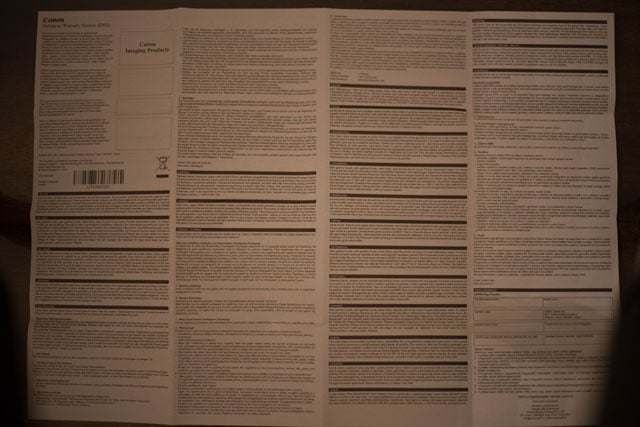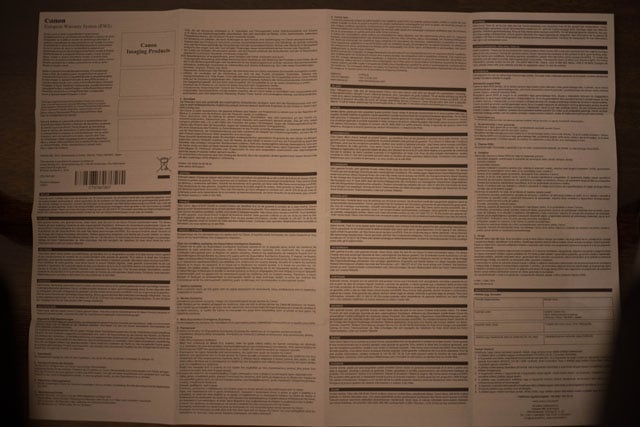Battle of the Nifty Fifties: Canon’s 50mm f/1.8 Lenses
![]()
This year, the Canon EF 50mm f/1.8 II, also called the “Nifty Fifty” celebrates its 25th birthday. Yes, that’s right: this lens was released back in December 1990 and is the second oldest lens that’s still in production. Yet it still dominates the list of the most popular Canon lenses, and for good reason: it’s cheap, it’s fast, it’s small and lightweight, and it offers good performance for the price, which makes it the first prime lens for most Canon owners.
But of course, being such an old lens does have its downsides, so Canon has just released the successor to the old Nifty Fifty: the new Canon EF 50mm f/1.8 STM.
A great alternative would be the Sigma 50mm f/1.4 Art lens. But while it may be a fantastic lens, it’s even more expensive and as a hobbyist photographer I’m not really dependent on its great performance. Also I wanted a lightweight, always-in-my-bag lens, and the Sigma is very heavy.
In the end I was very happy to hear news of the updated EF 50mm f/1.8 STM, and yesterday it arrived in my hands.
So here is my comparison of the old Nifty Fifty versus the new one: is it worth the higher price? Should you buy it if you already have the old version? Should you buy the STM version, or is the old version still a good choice?
It’s said that both lenses contain the same optical formula with the same number of optical elements. However the test results show much more differences than expected.
First Impressions of the STM
![]()
The very first impression you get when you hold the new STM lens in your hand for the first time is its less plasticky feel. In fact, it feels more like the polycarbonate top plating of my Canon EOS 6D. It’s great.
Mounts
![]()
The new STM has a metal mount (Yes!). One thing people often criticize the old EF 50mm II about is its plastic mount. Fear no more: The new STM version offers a robust metal mount.
Lens Hood
![]()
You can argue how useful a lens hood is in combination with the Nifty Fifties, as the front glass element is already deeper inside the lens body, but it offers an additional level of protection. This is very welcomed especially for external focusing lenses for which the front element extends when focusing on close objects. And to be honest: in my opinion lens hoods just look good.
The old EF 50mm II was never designed to work with a lens hood. There are a few third-party offerings, however you have to screw these hoods into the filter thread.
For the new STM version, Canon began offering the new ES-68 lens hood. Of course Canon users know the notorious Canon problem: only L-lenses come with lens hoods included. Therefore you have to order the lens hood separately and as usual they come with a hefty price tag.
I’m sure that there will be much cheaper third-party offerings soon. But well, I wanted it. Now. And it looks so much nicer with a lens hood in my opinion. I cannot name any other rational justification for ordering this piece of plastic for more than $30 right now when there will be options for around $10 available soon.
![]()
One nice thing with this lens hood is that it offers the same non-plastic feel as the lens itself and locks securely on the lens. You have to press a release button to unmount the hood. Of course it can also be mounted reverse to save storage place in your bag.
![]()
Focus-by-Wire
The focus ring of the Canon EF 50mm f/1.8 STM is broader than the very narrow focus ring of the old Nifty Fifty. However when you hold the lens in your hand you turn the ring, nothing happens. Then you mount it to the camera and still nothing happens. Then you switch it to manual focusing mode and suddenly turning the ring starts to work.
This is because the focus ring is no longer a mechanical focus ring, but an electronic control ring that steers the focus motor by wire. So in order to change the focus, the lens must be powered. One advantage of this focus by wire technology is that the lens offers an all-time manual focus override similar to the more expensive ring USM motors. But in auto focus mode this only works while the shutter is half-pressed. So you can half-press the shutter and the AF will focus on an object. While keeping the shutter half-pressed you can turn the focus ring to change the focus manually.
However, focus-by-wire comes with drawbacks.
One that is the biggest in my opinion is: since the lens does not offer internal focusing, the front lens element extends when focusing. This is the same with the old 50mm II, but in that case, you simply turned the focus ring to retract the front of the lens. Even when the lens isn’t mounted on the camera.
This is no longer possible with the new STM version. You can only retract the front lens element when 1) the lens is mounted to your camera, 2) the camera is powered on, and 3) the lens is switched to manual focusing mode or switched to auto focusing mode and while half-pressing the shutter.
Why is retracting the lens so important? Well, if the front lens is extended and you place the lens in your bag, if it is exposed to some pressure on the front element, the focusing motor could suffer damage. This is a known problem with the EF 50mm f/1.4 USM, for which users frequently experienced damaged AF motors and it’s recommend to always keep the lens hood on to protect the motor.
I am not sure how well the STM motor can handle this and I hope I will never find out. However with my old Nifty Fifty I developed the habit of always retracting the front element after unmounting the lens, but now that’s no longer possible.
Another drawback of focus-by-wire: Although focus follows the turn of the focus ring very fast and there is almost no delay, it is an entirely different feeling. Don’t get me wrong: Manual focusing works well enough. But each time you turn the ring, you hear the AF motor, which reminds you that this is just focus-by-wire.
In short: I don’t like it.
STM
STM stands for stepping motor, or the motor that drives the autofocus. According to Canon, STM should offer near silent focusing. Well, the sound of the AF motor is clearly noticeable in the EF 50mm f/1.8 STM. It’s not as loud as the old focusing motor in the older version, but I really wouldn’t call it near silent. The STM is still definitely louder than any of my other lenses with USM (ultra sonic motor). But then the Nifty Fifties are the only lenses without USM that I’m using today.
Luckily I am neither a video guy nor a wedding photographer shooting in a church, so I can live with the noise of the STM motor. What’s more important to me is the focusing speed. Good news: the new STM motor focuses faster and more accurately than the old focusing system of the EF 50mm II. In cases where the old lens tends to focus hunt, the new STM version finds the focus instantly.
Image Quality
Of course the most important aspect of any lens is the image quality. It should go without saying that you cannot expect perfect results from a $150 lens. There is a reason why Zeiss can sell the Otus 55mm 1.4 for more than $3,000 and why Sigma can charge so much for the 50mm f/1.4 DG HSM Art. It’s a question of performance per price, and by that measure the EF 50mm f/1.8 STM (as well as the older EF 50mm f/1.8 II) shines.
If you are a professional photographer, you probably should aim for the Sigma or the even the Zeiss. If photography is just a serious hobby like for me, the EF 50mm f/1.8 STM can be absolutely sufficient.
Lastly there is one thing that the old Nifty Fifty always offered despite its flaws: character! It’s not its perfectness that made it the most popular Canon lens, it’s the attractive price combined with its lovely characteristics. Vignetting? Soft corners? Let’s embrace it!
Many criticize the old nifty fifty for its aperture blade design. At narrower apertures the outline of the 5 aperture blades are clearly visible. The newer STM version offers 7 blades with an improved design that allows nearly round bokeh lights even when stepping down the aperture leading to a more pleasant bokeh, especially in combination with bright lights in out-of-focus areas.
Test Images
OK, enough has been written. Here are the test images. All images can be downloaded in full resolution and I encourage you to open the full resolution samples in separate browser tabs to be able to compare these more easily. The pictures were taken from a tripod at different apertures with both lenses. Focus was achieved through the live view in both cases on the same areas.
Note: The results I am presenting here are not the results of a scientific research and only cover my copies of the lenses. I might have good and bad copies, so take the results with a grain of salt.
Test Image: Moroccan Sugar Pot
A Moroccan sugar pot with fine details with candle lights and a bunch of flowers in the out-of-focus areas.


Download the samples in full resolution:
Canon EF 50mm f/1.8 II: Moroccan sugar pot shot at f/1.8
Canon EF 50mm f/1.8 II: Moroccan sugar pot shot at f/2.8
Canon EF 50mm f/1.8 II: Moroccan sugar pot shot at f/5.6
Canon EF 50mm f/1.8 II: Moroccan sugar pot shot at f/8.0
Canon EF 50mm f/1.8 STM: Moroccan sugar pot shot at f/1.8
Canon EF 50mm f/1.8 STM: Moroccan sugar pot shot at f/2.8
Canon EF 50mm f/1.8 STM: Moroccan sugar pot shot at f/5.6
Canon EF 50mm f/1.8 STM: Moroccan sugar pot shot at f/8.0
Let’s do some pixel peeping: We are starting with the center of this image, the fine details of the Moroccan sugar pot.
When shot wide open at f/1.8 we can see chromatic aberrations for both lenses, although these are slightly better controlled by the newer STM version. In both cases the chromatic aberrations disappear when stopping down to f/5.6. In terms of sharpness both lenses are very close. However the older version shows slightly more contrast.
Focusing on the candle the major improvements in rendering bokeh become apparent. While there is not much difference when shot wide open at f/1.8 the shape of the lights are much more pleasant with the new STM version. It’s almost impossible to detect the shape of the aperture blades, while the old EF 50mm II clearly exposes the pentagonal shapes. Also the bokeh of the new STM version appears to be creamier than the older version.
Looking at the flowers reinforces the improvements in the bokeh. The bokeh of the old EF 50mm II looks more turbulent, and the STM version displays a creamier bokeh.
Test Image: Manual
To judge the sharpness of the lens, I took a picture of the EF 50mm f/1.8 STM manual with both lenses. Note that the dark corners on the bottom are caused by the tripod legs, so please ignore these corners.


Canon EF 50mm f/1.8 II: Manual shot at f/1.8
Canon EF 50mm f/1.8 II: Manual shot at f/2.8
Canon EF 50mm f/1.8 II: Manual shot at f/5.6
Canon EF 50mm f/1.8 STM: Manual shot at f/1.8
Canon EF 50mm f/1.8 STM: Manual shot at f/2.8
Canon EF 50mm f/1.8 STM: Manual shot at f/5.6
The first thing you might notice from these images that both lenses show quite a bit of vignetting wide open. With profile corrections in modern RAW converters like Lightroom this isn’t too big of a problem. Personally I even like some vignetting and often add it in post. So this isn’t an issue to me. When stopping down to f/5.6 vignetting is no longer a problem in either lenses.
Here are the comparisons for pixel peepers: And again we are starting with the center.
At the first glance you can see that the new STM version offers a more consistence performance in terms of sharpness. Wide open it’s clearly sharper than the old version. When stopping down there is almost no noticeable improvement from f/2.8 to f/5.6.
The 50mm II however improves consistently. While softer wide open it improves at f/2.8 and again at f/5.6. What’s surprising is that the old Nifty Fifty manages to slightly surpass the sharpness of the new STM version at f/5.6 in the center. And not only that: The contrast of the older version looks also better.
So in terms of center sharpness the new EF 50mm STM is clearly better when shot wide open, but falls behind slightly when stopping down.
But let’s see what happens, when we look at the top left hand corner.
It’s almost like the old 50mm II wants to say: “Corner sharpness? Never heard about it.” The new 50mm STM can control corner sharpness much, much better and is the obvious winner here. Of course you cannot expect wonders from a $150 lens. But what you can see here is already very good and a huge improvement compared to the old Nifty Fifty.
However if you really need a lens that is tack sharp from the center to the corners, even when wide open, you will have to pay much more.
Test Image: Christmas Lights
Well, this is a must-have test image, isn’t it? Why else would you like to buy a fast prime lens, if it’s not for shooting Christmas lights?


Download the samples in full resolution:
Canon EF 50mm f/1.8 II: Christmas lights shot at f/1.8
Canon EF 50mm f/1.8 II: Christmas lights shot at f/2.8
Canon EF 50mm f/1.8 II: Christmas lights shot at f/5.6
Canon EF 50mm f/1.8 II: Christmas lights shot at f/8.0
Canon EF 50mm f/1.8 STM: Christmas lights shot at f/1.8
Canon EF 50mm f/1.8 STM: Christmas lights shot at f/2.8
Canon EF 50mm f/1.8 STM: Christmas lights shot at f/5.6
Canon EF 50mm f/1.8 STM: Christmas lights shot at f/8.0
And finally the crops for comparison:
I won’t comment on these samples. I’ll let you come to your own conclusions.
Minimum Focusing Distance
The minimum focusing distance has been reduced from 45cm (1.5ft) to 35cm (1.1ft). This means you can get closer to your subject while keeping it in focus, and therefore small objects can be pictured larger.
So how much of a difference in the field of view results from these 10cm difference in minimum focusing distance? Let’s have a look.


As you can see, the difference is pretty big. Of course the new STM is still far away from being a macro lens, but if you take close ups of larger objects very often you’ll love the new Nifty Fifty. Also I’ve used my 50mm II for a long time for shooting macros with extension tubes. Using the new STM you can use shorter extension tubes, which results in less light loss.
Pros and Cons
Canon EF 50mm f/1.8 II
![]()
Pros:
- Slightly better center sharpness (but this could be just my copies).
- Extends after focusing on close objects, but can be retracted when dismounted with the focus ring.
- Cheaper (in some markets)
- Lighter.
Cons:
- Bad corner sharpness at all apertures.
- Bad center sharpness, when shot wide open.
- Clearly visible aperture blade shapes at narrower apertures.
- Plastic mount.
- External focusing: Extends when focusing on close objects.
- Loud AF motor.
- Slow and sometimes inaccurate auto focus.
Canon EF 50mm f/1.8 STM
![]()
Pros:
- Much improved corner sharpness. Usable, even wide open.
- Overall improved sharpness when shot wide open.
- Better controlled chromatic aberrations, although still noticeable.
- Faster and more accurate auto focus.
- 7 aperture blades and new aperture blade design lead to nearly rounded bokeh lights, even at narrower apertures.
- Auto focus more silent.
- All-time manual focus override after half-pressing shutter.
- Lower minimum focusing distance: 0.35m instead of 0.45m.
- Metal mount.
- Thread for lens hood. Compatible lens hood ES-68 available. Lens hood with release button.
- Non-plastic feel.
- Overall better build quality.
- New lens cap design works better with lens hoods.
- Broader focus ring.
- Still very light and is a small lens that can stay in your bag.
Cons:
- Center sharpness and contrast not as good as the old EF 50mm II.
- External focusing: Extends when focusing on close objects. Cannot be manually retracted without power.
- Although the STM auto focus motor is more silent, it’s not as silent as you would expect it to be.
- Slightly more expensive in some markets.
- Notorious Canon issue: Lens hood sold separately and overpriced.
Concluding Remarks
Is the new Canon EF 50mm f/1.8 STM a worthy successor? I would say yes, definitely.
About the author: Carsten Schlipf is a photographer based in Gäufelden, Germany. He seeks to capture the beauty of everyday life through the viewfinder of his camera. You can connect with him through his website, Google+, and 1x. This review has also been published on his website.